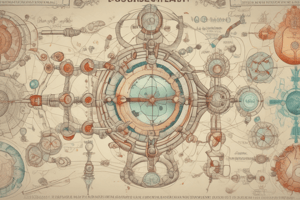Podcast
Questions and Answers
What is the primary function of signal peptides in peptide hormone synthesis?
What is the primary function of signal peptides in peptide hormone synthesis?
- To translate the mRNA into a protein
- To target the preprohormone to the Golgi apparatus (correct)
- To remove the prohormone
- To activate the hormone
What type of hormone is derived from the amino acid tryptophan?
What type of hormone is derived from the amino acid tryptophan?
- Steroid hormones
- Catecholamines
- Serotonin and Melatonin (correct)
- Thyroid hormones
What is the characteristic of peptide hormones in terms of solubility?
What is the characteristic of peptide hormones in terms of solubility?
- Prohormone soluble
- Golgi soluble
- Lipid soluble
- Water soluble (correct)
Which process involves the cleavage of a larger molecular weight precursor to form the active hormone?
Which process involves the cleavage of a larger molecular weight precursor to form the active hormone?
What is the term for the process by which a hormone acts on the same cell that produced it?
What is the term for the process by which a hormone acts on the same cell that produced it?
What is the term for the process by which gametes are formed?
What is the term for the process by which gametes are formed?
What are the three factors that determine the concentration of hormone as seen by target cells?
What are the three factors that determine the concentration of hormone as seen by target cells?
What is the role of a receptor in hormone-receptor interaction?
What is the role of a receptor in hormone-receptor interaction?
What is the term for the ability of a hormone-receptor interaction, defined by an equilibrium constant?
What is the term for the ability of a hormone-receptor interaction, defined by an equilibrium constant?
What type of molecule binds the receptor and induces all the post-receptor events that lead to a biologic effect?
What type of molecule binds the receptor and induces all the post-receptor events that lead to a biologic effect?
What is the term for the regular changes that occur in an organism's physiological processes over a 24-hour period?
What is the term for the regular changes that occur in an organism's physiological processes over a 24-hour period?
What is the term for the control of the heart rate by the autonomic nervous system?
What is the term for the control of the heart rate by the autonomic nervous system?
What is the primary function of the endocrine system?
What is the primary function of the endocrine system?
How do endocrine glands regulate hormone release?
How do endocrine glands regulate hormone release?
What is the difference between the endocrine system and the nervous system?
What is the difference between the endocrine system and the nervous system?
What is required for the endocrine system to transmit its hormonal messages?
What is required for the endocrine system to transmit its hormonal messages?
What is one of the principal functions of the endocrine system?
What is one of the principal functions of the endocrine system?
What triggers the secretion of a hormone?
What triggers the secretion of a hormone?
Flashcards are hidden until you start studying
Study Notes
Control, Maintenance, and Instigation of Sexual Reproduction
- Gametogenesis, coitus, fertilization, fetal growth and development, and nourishment of the newborn are the stages of sexual reproduction.
Types of Cell-to-Cell Signaling
- Neurohormones, paracrine, endocrine, and autocrine are the four types of cell-to-cell signaling.
Types of Hormones
- Hormones are categorized into four structural groups: peptides and proteins, amino acid derivatives, steroids, and fatty acid derivatives.
- Peptide hormones range from 3 to hundreds of amino acids in size and are often produced as larger molecular weight precursors.
- Peptide hormones are water-soluble and are produced through a specific gene transcribed into mRNA and translated into a protein precursor.
- Amino acid derivatives include amine hormones, thyroid hormones, and tryptophan-based hormones.
- Thyroid hormones are formed by incorporating 3 or 4 iodine atoms into a "double" tyrosine.
- The concentration of hormone as seen by target cells is determined by rate of production, rate of delivery, and rate of degradation and elimination.
Hormone-Receptor Interaction
- A receptor is a protein that binds a ligand with high affinity and low capacity.
- A tissue becomes a target for a hormone by expressing a specific receptor for it.
- Hormones circulate in the bloodstream but only cells with receptors for it are targets for its action.
- Agonists are molecules that bind the receptor and induce a biologic effect.
- Antagonists are molecules that bind the receptor and block binding of the agonist.
Principle of Endocrine System
- The endocrine system maintains homeostasis by acting on distant target cells to maintain the stability of the internal environment.
- The secretion of the hormone is evoked by a change in the environment, and the resulting action on the target cell restores the milieu to normal.
Endocrine Gland
- Endocrine glands synthesize and store hormones.
- These glands have a sensing and signaling system that regulates the duration and magnitude of hormone release via feedback from the target cell.
Endocrine System vs Neural System
- The endocrine system and the neural system are the two major communication systems in the body.
- The endocrine system broadcasts its hormonal messages to essentially all cells by secretion into the blood.
- Unlike the nervous system, the endocrine system is anatomically discontinuous.
Principal Functions of the Endocrine System
- The endocrine system maintains the internal environment in the body.
- The endocrine system integrates and regulates growth and development.
Studying That Suits You
Use AI to generate personalized quizzes and flashcards to suit your learning preferences.




